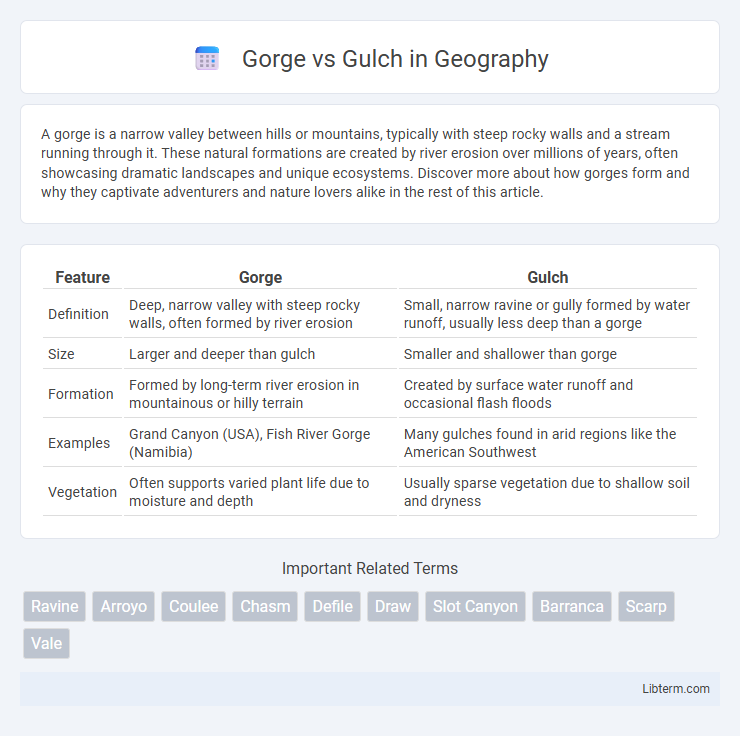A gorge is a narrow valley between hills or mountains, typically with steep rocky walls and a stream running through it. These natural formations are created by river erosion over millions of years, often showcasing dramatic landscapes and unique ecosystems. Discover more about how gorges form and why they captivate adventurers and nature lovers alike in the rest of this article.
Table of Comparison
| Feature | Gorge | Gulch |
|---|---|---|
| Definition | Deep, narrow valley with steep rocky walls, often formed by river erosion | Small, narrow ravine or gully formed by water runoff, usually less deep than a gorge |
| Size | Larger and deeper than gulch | Smaller and shallower than gorge |
| Formation | Formed by long-term river erosion in mountainous or hilly terrain | Created by surface water runoff and occasional flash floods |
| Examples | Grand Canyon (USA), Fish River Gorge (Namibia) | Many gulches found in arid regions like the American Southwest |
| Vegetation | Often supports varied plant life due to moisture and depth | Usually sparse vegetation due to shallow soil and dryness |
Introduction to Gorges and Gulches
Gorges and gulches are both landforms created through the natural process of erosion, where water cuts through rock and soil over time. A gorge is typically a deep, narrow valley with steep, rocky sides, often found in mountainous regions, and formed by river activity. Gulches are smaller, narrower channels that may experience intermittent water flow, often appearing as steep-sided ravines or dry streambeds in arid or semi-arid areas.
Defining a Gorge
A gorge is a deep, narrow valley with steep, rocky walls formed primarily by river erosion over geological time. Unlike broader valleys, gorges have a more pronounced vertical drop and often feature a fast-flowing stream or river at the bottom. This distinct topography results from the persistent cutting action of water through resistant rock layers.
What Makes a Gulch?
A gulch is a narrow, steep-sided ravine formed primarily by fast-flowing water that erodes the earth, often smaller and more sharply incised than a gorge. Unlike gorges, which can be broader and deeper valleys typically carved by persistent river activity over long geological periods, gulches usually result from rapid runoff, such as flash floods or seasonal streams. The defining characteristics of a gulch include its steep walls, narrow floor, and relatively short length compared to larger erosional landforms.
Key Differences Between Gorges and Gulches
Gorges are typically deep, narrow valleys with steep, rocky walls formed by long-term river erosion, whereas gulches are smaller, often dry, steep-sided ravines resulting from rapid water runoff or flash floods. Gorges often have perennial water flow and significant ecological diversity, contrasting with gulches that may only carry water temporarily during rainfall. The scale, water presence, and formation processes distinctly separate gorges from gulches in geomorphology.
Geological Formation Processes
Gorges form through long-term river erosion in regions with tectonic uplift, where water cuts deep, narrow valleys with steep sides typically in hard, resistant rock. Gulches result from rapid, intermittent water flow or flash flooding, primarily shaping shallow, narrow channels often filled with loose sediment and less resistant materials. Both formations reflect distinct geological processes influenced by rock type, climate, and hydrological dynamics.
Notable Examples Around the World
Notable examples of gorges include the Grand Canyon in the United States, characterized by its steep, deep walls formed by the Colorado River, and the Fish River Gorge in Namibia, Africa's largest gorge known for its dramatic cliffs and rugged terrain. In contrast, famous gulches such as the Gulch of the Enchanted in Spain feature narrow, shallow valleys with gentle slopes, often formed by seasonal streams. These natural formations highlight the distinct geological processes and environmental conditions that define gorges versus gulches worldwide.
Ecological Significance
Gorges and gulches serve crucial ecological roles by providing unique habitats that support diverse plant and animal species adapted to their specific microclimates. Gorges often harbor endemic species due to their steep, sheltered environments and stable moisture conditions, promoting biodiversity hotspots. Gulches, with their rapid water flow and sediment transport, contribute to nutrient cycling and connect upland and lowland ecosystems, enhancing overall ecological connectivity.
Recreational Activities
Gorges offer extensive hiking trails, rock climbing, and white-water rafting opportunities due to their steep walls and rapid river flows. Gulches, often smaller and less rugged, provide casual hiking, bird watching, and photography spots ideal for beginners and families. Both formations support camping and picnicking but differ in adventure intensity and accessibility for outdoor enthusiasts.
The Cultural Importance of Gorges and Gulches
Gorges and gulches hold significant cultural importance as natural landmarks that embody local heritage and traditional practices. Many indigenous communities view gorges as sacred spaces, often featuring in folklore, spiritual rituals, and historical narratives, while gulches frequently serve as vital ecological zones supporting biodiversity and local resource use. Preservation of these landforms contributes to maintaining cultural identity and fostering environmental stewardship across regions.
Conservation and Preservation Efforts
Conservation efforts in gorges emphasize maintaining natural water flow and preventing erosion through reforestation and controlled human access, preserving biodiversity hotspots unique to steep, narrow valleys. Preservation initiatives in gulches prioritize protecting fragile ecosystems from development by enforcing land-use regulations and promoting native vegetation restoration to combat habitat fragmentation. Both landforms benefit from coordinated watershed management programs that safeguard water quality and support sustainable wildlife habitats.
Gorge Infographic

 libterm.com
libterm.com